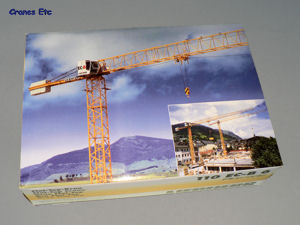 | | Picture box. |  | 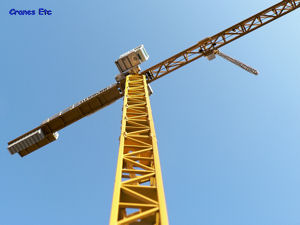 | | Mast sections differ. At the base it is one large continuous section. Above this they are modelled to reflect separate sections as used with a climbing frame. | 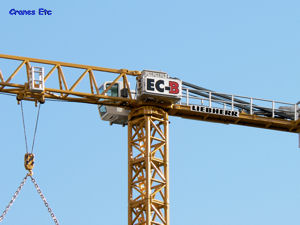 | | The winding tool is resting on the back jib for extra ballast. | 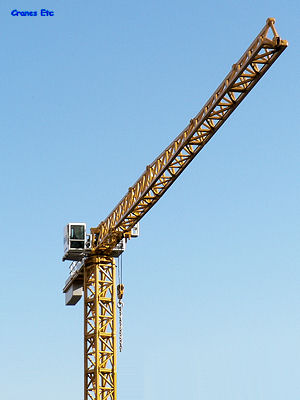 | | Jib is fully triangulated and very straight. | 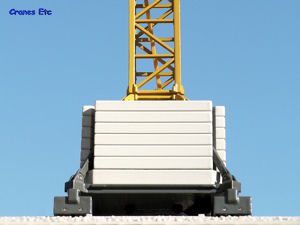 | | Ballast on the cruciform base. The model comes with a base section including rails for the bogies to run on. |
| The Liebherr EC-B small and medium range of tower cranes have an unusual design of mast head which includes the slewing gear, cab and all drives in a single unit. In typical configurations it has a maximum lifting capacity of 6t, a maximum radius of 55m lifting 1.4t at this radius, and a hook height of up to 51m.
Packaging
The crane is packed in the usual Liebherr picture box which contains an expanded polystyrene tray for the parts and a lid. Helpfully the trays are marked 'top' and 'bottom' so it is possible to avoid a selection of pieces around your feet caused by opening the trays upside down.
An instruction sheet is provided which is printed in German, English, French, Italian and Spanish. The instructions are simple and clear. The supplied model is slightly different to the instruction sheet in that the ballast at the base consists of six separate pieces, not four as described. One negative point is the method of fixing the mast sections together. Although this uses an established pinning method the NZG recommended way to hold the model together is to fix the connections with super glue. Many collectors will not like this permanent fixing method. An alternative method is to pack the pin holes with cotton or some other material so that when the pins are inserted a secure fix is obtained.
Detail
A plastic base is provided which provides a short length track for the crane bogies to travel on. The rails have stops at each end which helps to prevent the over-excited collector from pushing the model off the end of the track. Riding on the rails are the crane's bogies and these are metal, each with a pair of wheels. The cruciform base is all metal and the raking struts are individually pinned at each end.
Six solid ballast pieces provide the weight to hold the model stable and the four main blocks are cast to resemble stacks of concrete slabs and these look effective.
The mast sections are in three pieces. One is of a slightly different design and is intended to be the first section up from the base. The other two pieces are each made to replicate a combination of six short mast sections of the type which would be used with a climbing frame. Internally, plastic ladders and platforms add to the detail. The three mast pieces are joined together by using small pins which slot into mating holes. These connections are not tight, and a small tube of superglue is provided to fix the connection. The only surprising omission on the mast is the lack of a capacity board at the base indicating radius and loads and the real machine typically has a couple of access platforms at the top of the mast under the slewing ring.
At the mast head the detail is very good and reflects the complexity of the real machine. The cab has very good internal detail for a 1:87 model and has fine tinted glass with excellent 'FR.tronic' transfers on the windows. There are very good metal handrails around the mast head which surround the finely detailed switchgear box and drive motors. The counterweight jib has a replicated mesh walkway and metal handrails. An excellent piece of detail is the fold assembly supports for the guys which are hinged and actually work. At the rear the ballast block is a solid piece cast to resemble separate slabs and which slots into the counterweight jib notches. The only area lacking is the lattice work to the underside.
The main jib is cast in four separate pieces. In the box two pieces are already joined and the rest are assembled by the collector to make the jib. Casting is very good, with the lattice work being fully triangulated. Also included are some very small pulleys for the trolley control rope although these are not used in the model. The trolley is metal and includes a man riding basket. The hook is good but lacks a pulley inside the block.
Features
The crane can traverse along the tracks and the ballast at the base is heavy enough and the movement smooth enough not to cause concern about the modelling toppling over.
The crane rotates and the trolley can be moved by hand to any position along the jib. The hook can be raised and lowered and this is done by using a special tool which turns the winch drum. The hook is not heavy enough to lower under its own weight so it is best to hang a small load to keep the lines tight.
A variety of poses can be achieved with the crane able to be erected to three different heights. However for the skilled collector other possibilities exist. Many of the connections are pinned rather than riveted so with care it is possible to split the model into more pieces. Both the jib and counter jib can be separated from the mast head, and as shown here a shortened main jib configuration can be achieved.
Quality
NZG have produced a high quality tower crane model with an enhanced level of detail over many earlier models. Casting is very good and paintwork and graphics are all to a high standard.
Price
The model is good value for the quality and detail offered.
Overall
As a relatively new maker of 1:87 tower crane models, NZG have produced a model which is very good in many respects. It is marred a little by the superglue method of fixing of the mast sections which it is best too avoid if the model is ultimately to be resold.
Footnotes
The model first appeared at the BAUMA Equipment Exhibition in April 2007. It appeared at retailers in June 2007.
|
| |
| 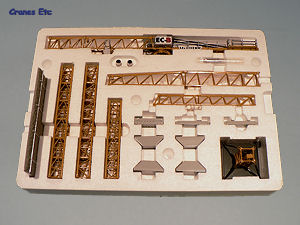 | | Parts in the tray. Track section on the left. | 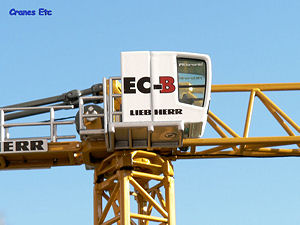 | | Excellent cab. | 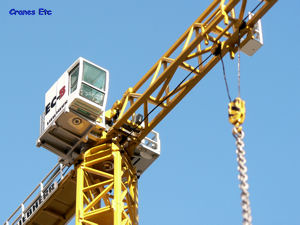 | | Mast head detail. | 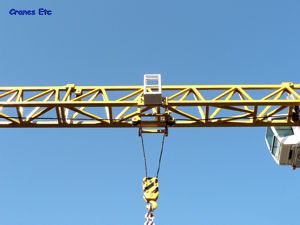 | | Very good trolley and hook, including trolley rope pulley hanging down where the jib sections join. | 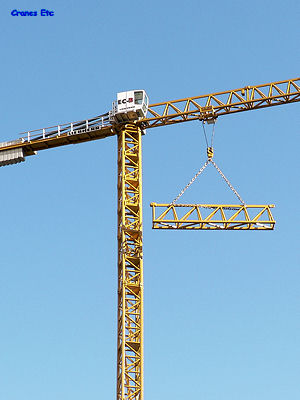 | | Crane shown lifting the jib section which has been removed to create a shorter configuration. |
|

